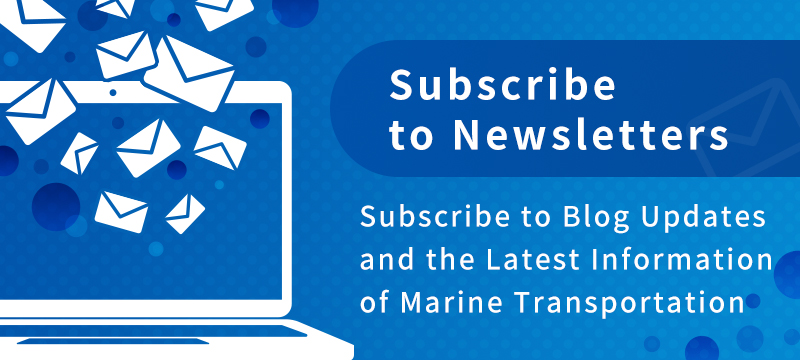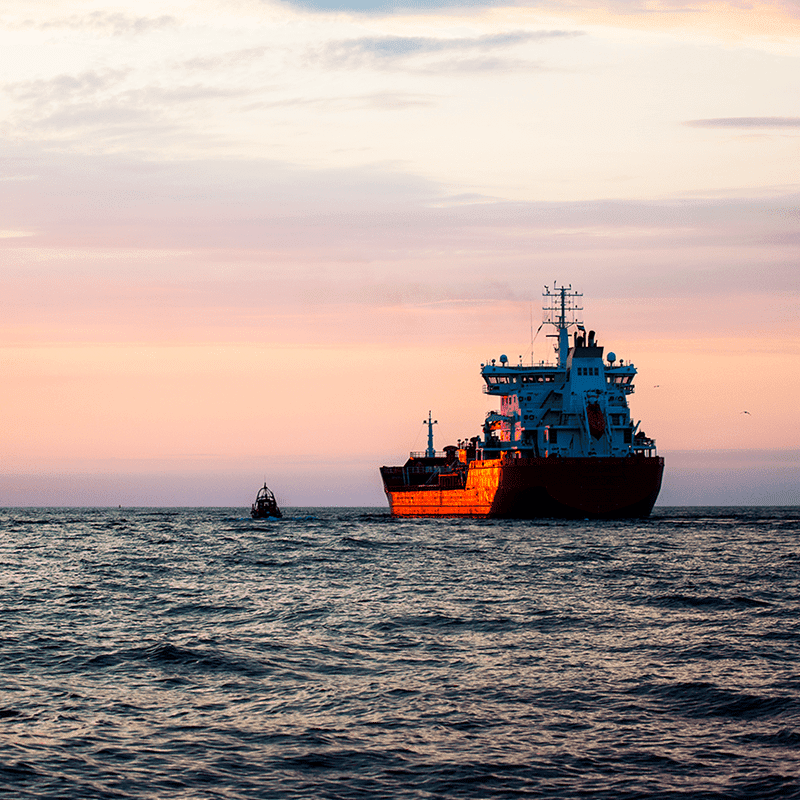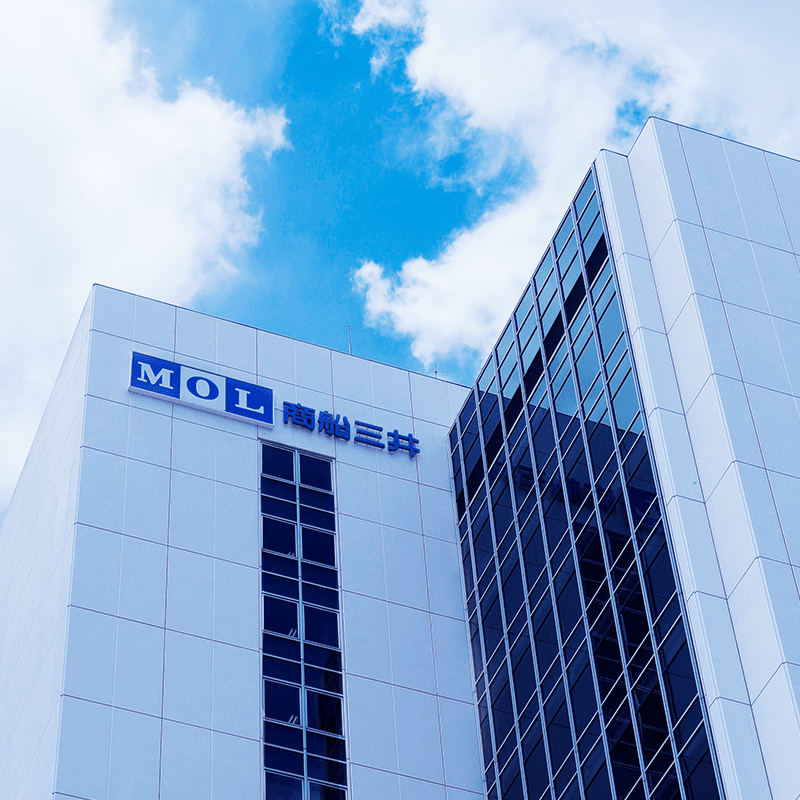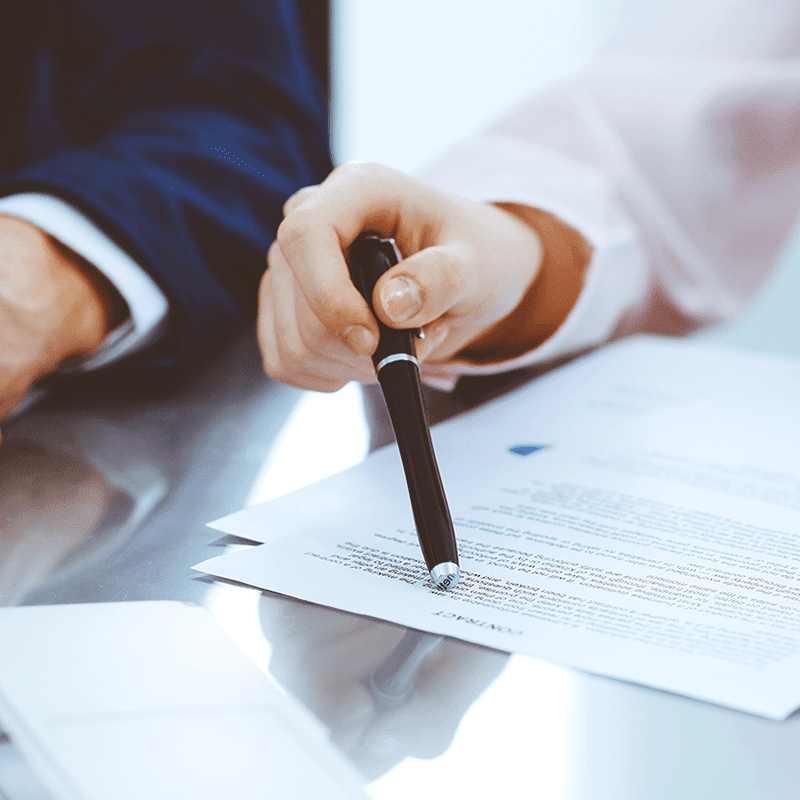BLOG
Aiming to be a Top Runner in Northern Sea Route Transportation
- Energy
2021.01.20
In recent years, the Northern Sea Route has been attracting attention, and Mitsui O.S.K. Lines (MOL) has been involved in the Northern Sea Route project as a pioneer in the transport of goods through this route. In 2018, MOL completed construction of the world's first ice-breaking LNG carrier and began transporting LNG (Liquid Natural Gas) from Russia to China via the Northern Sea Route (Summer only). MOL aims to be a leader in the Northern Sea Route Transportation industry in order to achieve both a stable transport of resources and a reduction in CO2 emissions. We will introduce an overview of the Northern Sea Route.
(Video) First loading operation of Ice-Breaking LNG Vessel
Overview of Arctic Ocean and the Northern Sea Route
The "Arctic Ocean" is the water surrounded by the Eurasian and North American continents with the North Pole at its center. In terms of landmasses, the ocean is surrounded by 5 countries: the United States, Russia, Canada, Denmark and Norway. The sea route between the Pacific Ocean and the Atlantic Ocean through the Arctic Ocean is called the "Northern Sea Route". Moreover, the Northern Sea Route can be roughly divided into two main routes: the "Northeast Passage" (Red line in the figure below), which passes along the Russian coast of the Eurasian continent, and the "Northwest Passage" (Yellow line in the figure below) which passes along the Canadian coast of the North American continent. Although these routes are called ‘passages’, the Arctic Ocean is covered extensively with sea ice and drift ice. Before 2000, ordinary ships rarely sailed through these areas.

Resorce: weathernews said 'the year's smallest area covered with ice on September 13th, 2020 and Open periods of Northern Sea Route
However, due to global warming in recent years, the extent of sea ice has been steadily decreasing, and since the 2000s the Northern Sea Route has gradually started to become passable. Since sea ice in the Arctic Ocean is affected by a variety weather conditions, the navigable period varies from year to year, but it is currently between August and October.
During the summer season, Russian nuclear-powered icebreakers basically lead the way in navigating the Arctic Ocean, breaking the sea ice and opening a waterway for cargo ships to follow. MOL’s ice breaking LNG carriers are capable of sailing eastward along the Northern Sea Route, via the Bering Strait, to East Asia, without icebreakers.
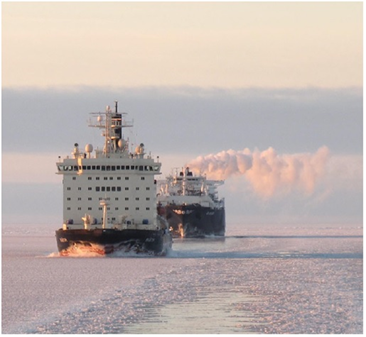
From the tanker CNIMF led by the icebreaker
Three reasons why the Northern Sea Route is attracting attention
As mentioned above, the extent of sea ice in the Arctic Ocean has been on a declining trend. In particular, the amount of ice has been decreasing in the summer, making it possible for ships to pass through the Arctic Ocean. This has led to discussions on the use of the Northern Sea Route to connect East Asia and Europe to become active in both Japan and overseas. In Japan, the 2014 Basic Plan for Ocean Policy (Plan for the Third Term) by the Cabinet Office called for the establishment of a system to forecast the distribution of sea ice and the development of infrastructure for using the Northern Sea Route, as part of systematic measures for the government to take.
There are three main reasons the Northern Sea Route has attracted attention:
① Reduced time at sea and less greenhouse gas emissions
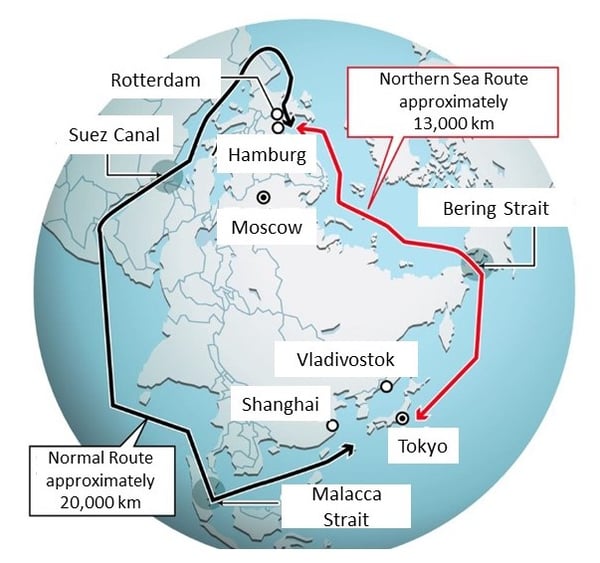
Resource: The SANKEI NEWS Normal Route and Northern Sea Route
(translated by MOL)
When sailing between Europe/Russia and East Asia, the use of the Northern Sea Route significantly reduces the navigation distance. For example, the normal route between Tokyo Port and Rotterdam Port, the Netherlands, via the Suez Canal, is approximately 20,000 km, whereas the route via the Arctic Ocean is approximately 13000 km, reducing the navigation distance by more than 30%. Shorter distances not only means shorter voyages but also reduces fuel consumption, which in turn reduces the amount of greenhouse gases emitted by shipping vessels.
MOL’s Northern Sea Route from the Russian Arctic Circle to East Asia means a navigation distance approximately 65% shorter than that via the Suez Canal, which in turn contributes to a reduction in greenhouse gas emissions.
② Abundant resources in the Arctic Ocean
The second reason is that it is possible to transport resources such as crude oil, natural gas and other resources which are abundantly present in the Arctic Ocean. In fact, Novatek, a Russian company, has developed a natural gas field and constructed an LNG plant and an export port in the central part of the Yamal Peninsula, (Yamaru means "End of the World" in the local Nenets language), facing the Arctic Ocean, and began shipping LNG to East Asia and Europe in 2017. Its annual LNG production capacity is 16.5 million tons, making it one of the world's largest LNG production bases. In December 2017, the 1st ice-breaking LNG carrier left the export port of Yamal Sabetta, and MOL is operating 3 ice-breaking LNG carriers from Yamal. In addition, in a transportation project for other shipping bases in the region, MOL has been steadily contributing to the stable transportation of resources by completing and introducing 3 new ice-breaking LNG carriers, to be fully operational by 2023.
(Click here for press release)

(LNG transport route from Yamal LNG terminal)
③ Avoiding areas of piracy
The third reason is one of safety as there is no possibility of encountering pirates. Normally, when going back and forth between Europe and Asia via the Suez Canal, it is necessary to pass through the Gulf of Aden (off the coast of Somalia) and the Strait of Malacca. However, many pirates are present in these waters and straits, and the navies of various countries, including the Japanese Self-Defense Forces, are engaged in escorting cargo ships. Passage through the Northern Sea Route avoids areas of high piracy risk, making it a very advantageous route for cargo ships with large payloads that are targeted by pirates.
New Initiatives to Strengthen Northern Sea Route Transportation
In order to operate LNG carriers from the Yamal LNG terminal, the seafarers of MOL’s icebreaking LNG carriers undergo special training, such as ice navigation training and extreme cold weather survival training, at a training center operated by Makarov University (full name: Admiral Makarov State University of Maritime and Inland Shipping). In September 2019, MOL signed a memorandum of understanding with Makarov University for Northern Sea Route operations and a cadetship program. We are arranging a long-term plan to hire trainees from the university and train them as future captains and chief engineers of vessels operated by MOL. This is part of our efforts to work actively in contributing to the demand for transportation of energy resources and products from the Arctic region. By promoting the training of seafarers suitable for navigating in the harsh Arctic Ocean conditions, we will stay at the forefront of transporting goods via the Northern Sea Route.
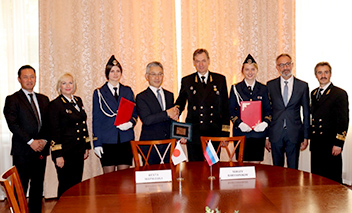
In the second article of this series, we will look at the structure of the icebreaking LNG carrier and future prospects for the Northern Sea Route.
MOL is not only reducing its greenhouse gas emissions, but also expanding its low-carbon business initiatives. One of these is the FSRU (Floating body type LNG storage Re-Gasification facility) business. This is a special solution for realizing low cost and quick installation of LNG facilities as the demand for LNG increases due to its acceptance as a more environmentally friendly energy resource worldwide. As the only FSRU owner and operator in Japan, MOL can provide a great insight into the FSRU business.

Writer:Ayu
Joined MOL in 2008. I’ve been in charge of operating oil tankers and bulk carriers for abt 7 years. And now I am currently involved in the operation of this site, in the marketing department.
I'm also in charge of managing MOL’s LinkedIn account. Please follow us! My favorite is K-Pop music :)
Recommended Articles
2022.07.05
- General Shipping
2021.04.13
- Energy
2025.03.18
- General Shipping
2021.08.07
- Eco Friendly
Latest Articles
2025.12.09
- Eco Friendly
- General Shipping
2025.12.03
- General Shipping
2025.11.20
- Energy
- General Shipping
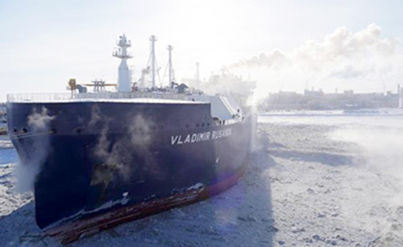

.png)


